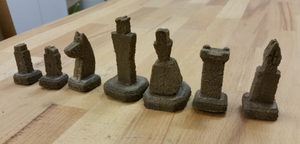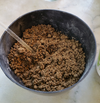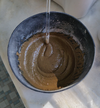Project:Airlag Chess Figures: Difference between revisions
m (Reverted edits by NitramLegov (talk) to last revision by Airlag) Tags: Rollback mobile edit mobile web edit |
m (Lukas moved page Project:Airlag chess figures to Project:Airlag Chess Figures: consistent capitalization) |
||
| (One intermediate revision by the same user not shown) | |||
| Line 1: | Line 1: | ||
{{ProjectInfoBox | {{ProjectInfoBox | ||
|project title=Chess Figures | |project title=Geopolymer Chess Figures | ||
|image=Airlag chess figures 20191004 185618.png | |image=Airlag chess figures 20191004 185618.png | ||
|status=in progress | |status=in progress | ||
Latest revision as of 19:45, 22 September 2022
| ProjectInfoBox Geopolymer Chess Figures | |
|---|---|

| |
| Status: | in progress |
| Release Date: | christmas time - maybe |
| Initiator: | Airlag |
| Materials Used: | styrene foam, silicone rubber, alkali activates silicates |
| Tools Used: | sharp knife, drying oven |
| Approx. Cost: | 80 € |
This is my first project I'm doing in the CoMakingSpace for real. I thought about a few other projects but those never made it past the thinking and sketching part.
A few months ago I stumbled over some information about Geopolymers in the internet:
- wikipedia -> Geopolymer
- YouTube -> Vulkanstein, der Baustoff der Zukunft?
- YouTube -> Cement From Trash: Green Alkali-Activated Cements
- gillmanbuilders -> Was ist Geopolymer Beton und wie man es selbst kocht
- scitation.org -> A Review in Geopolymer Binder with Dry Mixing Method
and several more. (In this context it is irrelevant whether it is historical correct if the pyramids were partly built using concrete or not)
The recipe varies from website to website. Wiki explains that there is a wide variety of ingedients that can replace each other. Therefore I started my own experimental research with available or easily accessable materials.
One of the ingredients is soda lye (NaOH). This chemical is corrosive.
The materials and chemicals aren't expensive. The most expensive is definitely the silicone rubber. I'm not finished jet but I expect there will be lots of leftovers.
Portland Cement Free Concrete
Trial 1
the activator:
6g water
add 4g NaOH slowly because the chemical reaction produces heat
add 25g sodium silicate
the aggregate:
185g sand (unknown origin, turned out it contained lots of limestone)
add 100g Zeolith powder
add the activator to the aggregate
Zeolith is a relatively cheap mineral. I ordered some powder. I got granumate instead. I tried anyways.
The resulting mixture was in no way pourable. I tried to pack it, then I let the chemistry magic do its job.
After a week it was hard but porose and crumbly.
Trial 2
the activator: same as above
6g water
add 4g NaOH
add 25g sodium silicate
the aggregate:
200g trass powder (Trass is the local name of a volcanic tuff occurring in the Eifel, Germany)
100g white sand from a pet shop
add the activator to the aggregate
The resulting mixture looked like moist sand but was very squashy. The mixture was not pourable.
After a week it was still moist and squashy.
Baking it in a drying oven at 80°C for 3 hours turned it to a rock.
After another week I discovered that the reference body shows some cracks.
Several weeks later it seems to sweat out some kind of nearly white powder. The cracks seem to get smaller.
Trial 3
the activator: same as above just 4 times more of it
24g water
add 16g NaOH
add 100g sodium silicate
the aggregate:
200g trass powder
add 100g white sand
add the activator to the aggregate
The resulting mixture is creamy but still not pourable. However, I tried this mixture for a first atempt on the chess figures (see below).
This time I put it immediately into the drying oven at about 60°C for 3 hours. The resulting reference body seemed hard but it isn't entirely. Hitting the edge of a table caused a dent in the reference body. One week later nothing has changed. The hardened material is as durable as chalk.
Trial 4
the activator:
30g water
add 18g NaOH
add 40g sodium silicate
the aggregate:
140g trass powder
add 200g white sand
add 4g titan white (just for the color)
add 80g water
add the activator to the aggregate
This recipe was from another web page. In my opinion there are two main differences. The mix ratios differ greatly. There is way more water involved as needed to dissolve the lye. And the aggregate is mixed with water before the activator is added.
The aggregate was creamy after mixing with water. When I added the activator it turned into a pourable liquid. That looked promising - at first.
I filled the cases and baked them in the drying oven at 70°C for about two days. The result was not durable at all. It crumbled literally at sight.
The Chess Figures
I want to make chess figures out of liquid stone.
For this I need casts.
To make casts I need prototype figures.
I decided to use styrene foam, a penknife and glue to create my prototypes. I had some square meters of 5mm panels lying around. So I used that material. It's very easy to cut but it's hard to carve tiny details. The material tends to crumble if you don't use the sharpest possible knife.
I wasn't satisfied with the first set of figures, so I made a second set.
Next I created small boxes for each figure out of the same material. I glued one figure to the bottom of each box, then I poured silicone rubber in the box. Two hours later I removed the box and cut the silicone rubber in half. After removing the remains of the prototype figure the reusable cases for the stone figures are finished.
I didn't make much pictures. Shame on me. I only have this picture of the first set of prototype figures.
Figures Trial 1 from Material Trial 3
Material Trial 3 seemed promising enough, so I poured it as good as possible into the silicone cases. The material was creamy, not liquid. So I ended up with several bubbles. The horse has no chin. The queen broke in half. Anyways, it's the first attempt. So here are the results.
And then I threw them away. Next try will be better :-)
Figures Trial 2 from Material Trial 4
A total fail.
One Year later
As you can imagine, I wasn't pleased by the results I documented above. I wasn't even writing about my last attempt with Material Trial 3, what had been the most promising. No photos, sorry ;) As far as I remember, I filled my cases as good as possible, baked them at about 60° and waited for a week or so. Then I carefully removed the figures from the cases. Still no better result. The material was just as hard as chalk. So I put the figures aside in a bookcase and forgot about them. For a whole year. Recently I stumbled over the figures. Just out of curiosity or maybe to finally throw them away, I took one. It felt hard. Totally not like chalk. The figures are hard as stone. Maybe not as hard as concrete but definitely no longer crumbling.
So the basic chemistry works! It just takes way longer than expected to turn solid.















